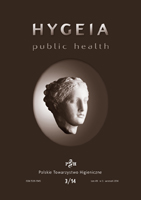Home page |
Editorial Board |
Editor |
Subscription |
Infomation for authors |
Conferences |
Partners

|
|
|
ISSN 1509-1945
 
 
  search by |
Hygeia Public Health 2021, 56(1): 1-13pl
 Food allergies and intolerances - the role of an elimination dietElżbieta Waśniewska 1/, Karolina Wrońska 2/, Marta Topolan 3/, Tomasz Bołdowski 4/, Paulina Wojtyła-Buciora 4/ 1/ Wojewódzka Stacja Sanitarno-Epidemiologiczna w Warszawie 2/ Powiatowa Stacja Sanitarno-Epidemiologiczna w Jeleniej Górze 3/ Powiatowa Stacja Sanitarno-Epidemiologiczna w Ostrowie Wielkopolskim 4/ Akademia Kaliska im. Prezydenta Stanisława Wojciechowskiego Summary The increase in the incidence of food allergies and intolerances has been recorded since the 1980s. Food allergies and intolerances constitute a significant health care problem, which includes the correct medical diagnosis, and the adherence to dietary recommendations; they also include social aspects. A practical knowledge of diagnosis and treatment has become a very important element in the work of dieticians, family doctors and paediatricians. In recent years, enormous progress has been made in this field, which significantly affects the well-being of patients suffering from these diseases. A properly balanced diet plays a key role in the prevention of diet-related diseases, including food allergies. The only effective method of treating food hypersensitivity is to eliminate the harmful product from the diet. An elimination diet consists in excluding from the daily diet products suspected of causing hypersensitivity, with simultaneous observation of clinical symptoms. The optimal period for eliminating a given product from the diet is 7-10 days. Elimination consists in excluding certain products from the menu, it is not enough to limit them. Key words: allergies, food intolerances, elimination diet |


